Western Sydney University: Primary Health Care for Older People Essay
VerifiedAdded on 2023/04/20
|7
|2187
|412
Essay
AI Summary
This essay provides a comprehensive analysis of primary health care services for older people, addressing the critical aspects of resource allocation, service delivery models, and the socio-political issues influencing aged care. The introduction sets the stage by emphasizing the significance of primary health care in enhancing the well-being of the elderly population and its impact on the community. The essay delves into the core of primary health care, examining its functional characteristics, the importance of geriatric assessments, and the role of laws and legislation. It evaluates various service delivery models, including community care centers, daycare facilities, and home care services, while also discussing the allocation of resources. The essay uses a social capital approach to critically discuss the effectiveness of health care services, addressing the challenges and opportunities in providing care. The conclusion summarizes the key findings, reinforcing the significance of a person-centered approach in delivering high-quality primary health care to older individuals, emphasizing the need for health promotion and well-being.
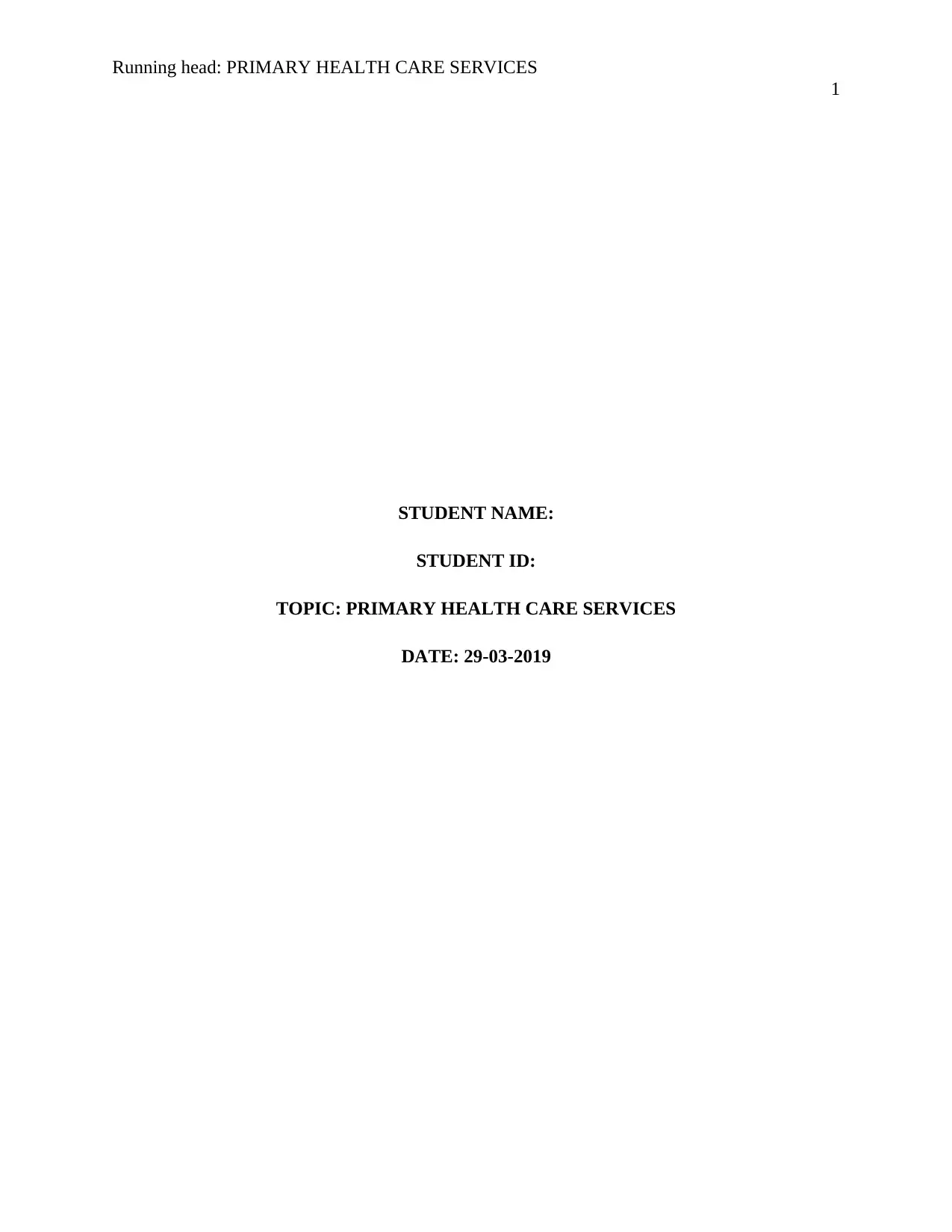
Running head: PRIMARY HEALTH CARE SERVICES
1
STUDENT NAME:
STUDENT ID:
TOPIC: PRIMARY HEALTH CARE SERVICES
DATE: 29-03-2019
1
STUDENT NAME:
STUDENT ID:
TOPIC: PRIMARY HEALTH CARE SERVICES
DATE: 29-03-2019
Paraphrase This Document
Need a fresh take? Get an instant paraphrase of this document with our AI Paraphraser
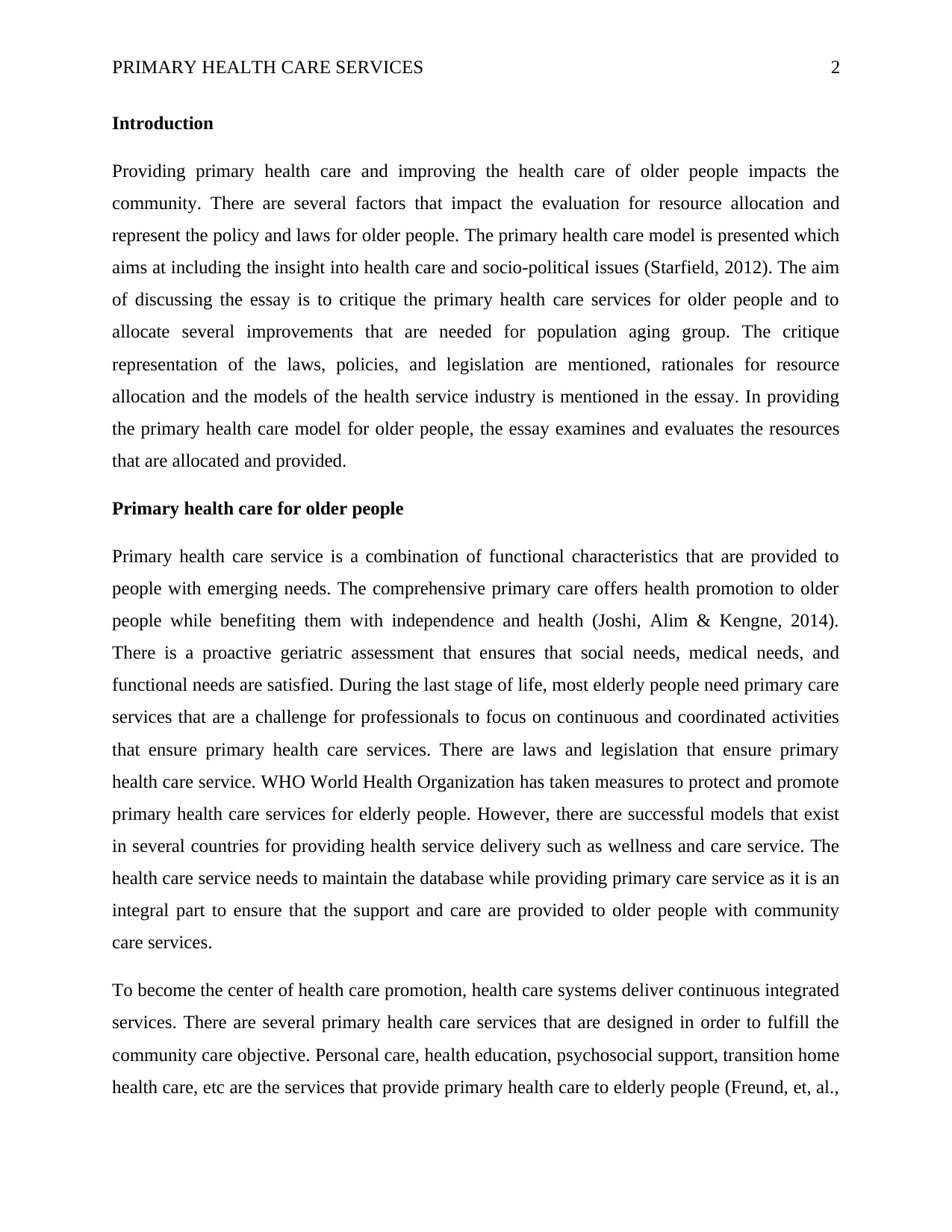
PRIMARY HEALTH CARE SERVICES 2
Introduction
Providing primary health care and improving the health care of older people impacts the
community. There are several factors that impact the evaluation for resource allocation and
represent the policy and laws for older people. The primary health care model is presented which
aims at including the insight into health care and socio-political issues (Starfield, 2012). The aim
of discussing the essay is to critique the primary health care services for older people and to
allocate several improvements that are needed for population aging group. The critique
representation of the laws, policies, and legislation are mentioned, rationales for resource
allocation and the models of the health service industry is mentioned in the essay. In providing
the primary health care model for older people, the essay examines and evaluates the resources
that are allocated and provided.
Primary health care for older people
Primary health care service is a combination of functional characteristics that are provided to
people with emerging needs. The comprehensive primary care offers health promotion to older
people while benefiting them with independence and health (Joshi, Alim & Kengne, 2014).
There is a proactive geriatric assessment that ensures that social needs, medical needs, and
functional needs are satisfied. During the last stage of life, most elderly people need primary care
services that are a challenge for professionals to focus on continuous and coordinated activities
that ensure primary health care services. There are laws and legislation that ensure primary
health care service. WHO World Health Organization has taken measures to protect and promote
primary health care services for elderly people. However, there are successful models that exist
in several countries for providing health service delivery such as wellness and care service. The
health care service needs to maintain the database while providing primary care service as it is an
integral part to ensure that the support and care are provided to older people with community
care services.
To become the center of health care promotion, health care systems deliver continuous integrated
services. There are several primary health care services that are designed in order to fulfill the
community care objective. Personal care, health education, psychosocial support, transition home
health care, etc are the services that provide primary health care to elderly people (Freund, et, al.,
Introduction
Providing primary health care and improving the health care of older people impacts the
community. There are several factors that impact the evaluation for resource allocation and
represent the policy and laws for older people. The primary health care model is presented which
aims at including the insight into health care and socio-political issues (Starfield, 2012). The aim
of discussing the essay is to critique the primary health care services for older people and to
allocate several improvements that are needed for population aging group. The critique
representation of the laws, policies, and legislation are mentioned, rationales for resource
allocation and the models of the health service industry is mentioned in the essay. In providing
the primary health care model for older people, the essay examines and evaluates the resources
that are allocated and provided.
Primary health care for older people
Primary health care service is a combination of functional characteristics that are provided to
people with emerging needs. The comprehensive primary care offers health promotion to older
people while benefiting them with independence and health (Joshi, Alim & Kengne, 2014).
There is a proactive geriatric assessment that ensures that social needs, medical needs, and
functional needs are satisfied. During the last stage of life, most elderly people need primary care
services that are a challenge for professionals to focus on continuous and coordinated activities
that ensure primary health care services. There are laws and legislation that ensure primary
health care service. WHO World Health Organization has taken measures to protect and promote
primary health care services for elderly people. However, there are successful models that exist
in several countries for providing health service delivery such as wellness and care service. The
health care service needs to maintain the database while providing primary care service as it is an
integral part to ensure that the support and care are provided to older people with community
care services.
To become the center of health care promotion, health care systems deliver continuous integrated
services. There are several primary health care services that are designed in order to fulfill the
community care objective. Personal care, health education, psychosocial support, transition home
health care, etc are the services that provide primary health care to elderly people (Freund, et, al.,
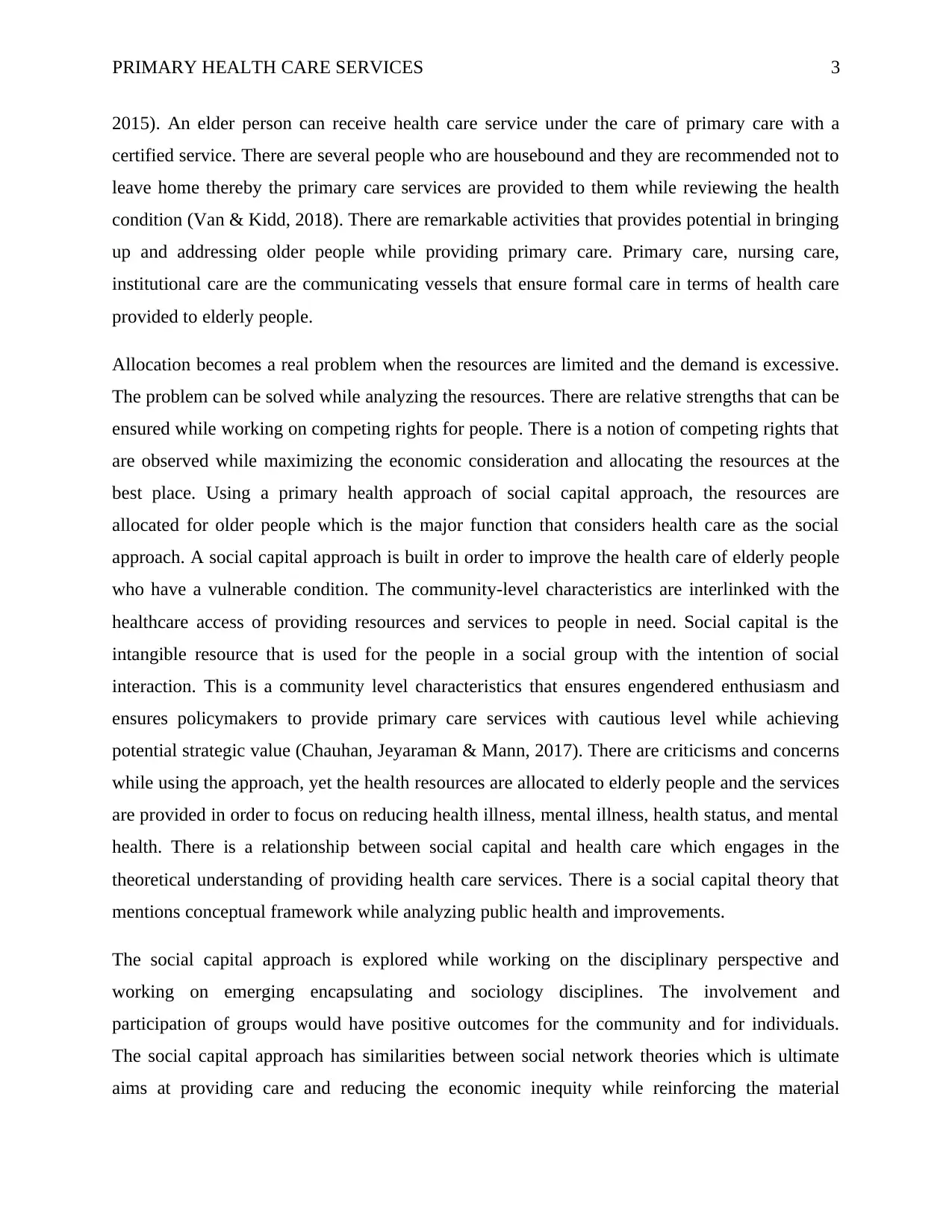
PRIMARY HEALTH CARE SERVICES 3
2015). An elder person can receive health care service under the care of primary care with a
certified service. There are several people who are housebound and they are recommended not to
leave home thereby the primary care services are provided to them while reviewing the health
condition (Van & Kidd, 2018). There are remarkable activities that provides potential in bringing
up and addressing older people while providing primary care. Primary care, nursing care,
institutional care are the communicating vessels that ensure formal care in terms of health care
provided to elderly people.
Allocation becomes a real problem when the resources are limited and the demand is excessive.
The problem can be solved while analyzing the resources. There are relative strengths that can be
ensured while working on competing rights for people. There is a notion of competing rights that
are observed while maximizing the economic consideration and allocating the resources at the
best place. Using a primary health approach of social capital approach, the resources are
allocated for older people which is the major function that considers health care as the social
approach. A social capital approach is built in order to improve the health care of elderly people
who have a vulnerable condition. The community-level characteristics are interlinked with the
healthcare access of providing resources and services to people in need. Social capital is the
intangible resource that is used for the people in a social group with the intention of social
interaction. This is a community level characteristics that ensures engendered enthusiasm and
ensures policymakers to provide primary care services with cautious level while achieving
potential strategic value (Chauhan, Jeyaraman & Mann, 2017). There are criticisms and concerns
while using the approach, yet the health resources are allocated to elderly people and the services
are provided in order to focus on reducing health illness, mental illness, health status, and mental
health. There is a relationship between social capital and health care which engages in the
theoretical understanding of providing health care services. There is a social capital theory that
mentions conceptual framework while analyzing public health and improvements.
The social capital approach is explored while working on the disciplinary perspective and
working on emerging encapsulating and sociology disciplines. The involvement and
participation of groups would have positive outcomes for the community and for individuals.
The social capital approach has similarities between social network theories which is ultimate
aims at providing care and reducing the economic inequity while reinforcing the material
2015). An elder person can receive health care service under the care of primary care with a
certified service. There are several people who are housebound and they are recommended not to
leave home thereby the primary care services are provided to them while reviewing the health
condition (Van & Kidd, 2018). There are remarkable activities that provides potential in bringing
up and addressing older people while providing primary care. Primary care, nursing care,
institutional care are the communicating vessels that ensure formal care in terms of health care
provided to elderly people.
Allocation becomes a real problem when the resources are limited and the demand is excessive.
The problem can be solved while analyzing the resources. There are relative strengths that can be
ensured while working on competing rights for people. There is a notion of competing rights that
are observed while maximizing the economic consideration and allocating the resources at the
best place. Using a primary health approach of social capital approach, the resources are
allocated for older people which is the major function that considers health care as the social
approach. A social capital approach is built in order to improve the health care of elderly people
who have a vulnerable condition. The community-level characteristics are interlinked with the
healthcare access of providing resources and services to people in need. Social capital is the
intangible resource that is used for the people in a social group with the intention of social
interaction. This is a community level characteristics that ensures engendered enthusiasm and
ensures policymakers to provide primary care services with cautious level while achieving
potential strategic value (Chauhan, Jeyaraman & Mann, 2017). There are criticisms and concerns
while using the approach, yet the health resources are allocated to elderly people and the services
are provided in order to focus on reducing health illness, mental illness, health status, and mental
health. There is a relationship between social capital and health care which engages in the
theoretical understanding of providing health care services. There is a social capital theory that
mentions conceptual framework while analyzing public health and improvements.
The social capital approach is explored while working on the disciplinary perspective and
working on emerging encapsulating and sociology disciplines. The involvement and
participation of groups would have positive outcomes for the community and for individuals.
The social capital approach has similarities between social network theories which is ultimate
aims at providing care and reducing the economic inequity while reinforcing the material
⊘ This is a preview!⊘
Do you want full access?
Subscribe today to unlock all pages.

Trusted by 1+ million students worldwide
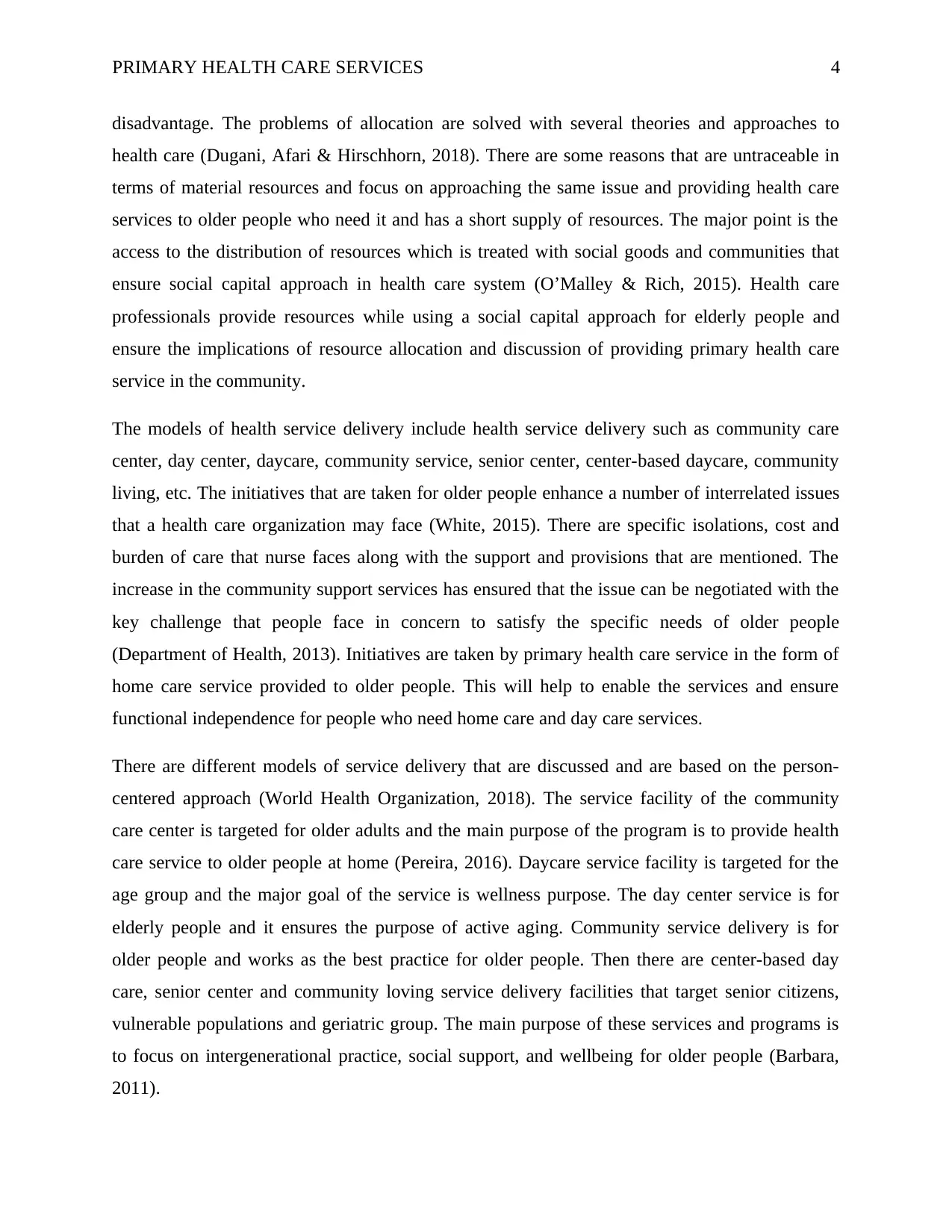
PRIMARY HEALTH CARE SERVICES 4
disadvantage. The problems of allocation are solved with several theories and approaches to
health care (Dugani, Afari & Hirschhorn, 2018). There are some reasons that are untraceable in
terms of material resources and focus on approaching the same issue and providing health care
services to older people who need it and has a short supply of resources. The major point is the
access to the distribution of resources which is treated with social goods and communities that
ensure social capital approach in health care system (O’Malley & Rich, 2015). Health care
professionals provide resources while using a social capital approach for elderly people and
ensure the implications of resource allocation and discussion of providing primary health care
service in the community.
The models of health service delivery include health service delivery such as community care
center, day center, daycare, community service, senior center, center-based daycare, community
living, etc. The initiatives that are taken for older people enhance a number of interrelated issues
that a health care organization may face (White, 2015). There are specific isolations, cost and
burden of care that nurse faces along with the support and provisions that are mentioned. The
increase in the community support services has ensured that the issue can be negotiated with the
key challenge that people face in concern to satisfy the specific needs of older people
(Department of Health, 2013). Initiatives are taken by primary health care service in the form of
home care service provided to older people. This will help to enable the services and ensure
functional independence for people who need home care and day care services.
There are different models of service delivery that are discussed and are based on the person-
centered approach (World Health Organization, 2018). The service facility of the community
care center is targeted for older adults and the main purpose of the program is to provide health
care service to older people at home (Pereira, 2016). Daycare service facility is targeted for the
age group and the major goal of the service is wellness purpose. The day center service is for
elderly people and it ensures the purpose of active aging. Community service delivery is for
older people and works as the best practice for older people. Then there are center-based day
care, senior center and community loving service delivery facilities that target senior citizens,
vulnerable populations and geriatric group. The main purpose of these services and programs is
to focus on intergenerational practice, social support, and wellbeing for older people (Barbara,
2011).
disadvantage. The problems of allocation are solved with several theories and approaches to
health care (Dugani, Afari & Hirschhorn, 2018). There are some reasons that are untraceable in
terms of material resources and focus on approaching the same issue and providing health care
services to older people who need it and has a short supply of resources. The major point is the
access to the distribution of resources which is treated with social goods and communities that
ensure social capital approach in health care system (O’Malley & Rich, 2015). Health care
professionals provide resources while using a social capital approach for elderly people and
ensure the implications of resource allocation and discussion of providing primary health care
service in the community.
The models of health service delivery include health service delivery such as community care
center, day center, daycare, community service, senior center, center-based daycare, community
living, etc. The initiatives that are taken for older people enhance a number of interrelated issues
that a health care organization may face (White, 2015). There are specific isolations, cost and
burden of care that nurse faces along with the support and provisions that are mentioned. The
increase in the community support services has ensured that the issue can be negotiated with the
key challenge that people face in concern to satisfy the specific needs of older people
(Department of Health, 2013). Initiatives are taken by primary health care service in the form of
home care service provided to older people. This will help to enable the services and ensure
functional independence for people who need home care and day care services.
There are different models of service delivery that are discussed and are based on the person-
centered approach (World Health Organization, 2018). The service facility of the community
care center is targeted for older adults and the main purpose of the program is to provide health
care service to older people at home (Pereira, 2016). Daycare service facility is targeted for the
age group and the major goal of the service is wellness purpose. The day center service is for
elderly people and it ensures the purpose of active aging. Community service delivery is for
older people and works as the best practice for older people. Then there are center-based day
care, senior center and community loving service delivery facilities that target senior citizens,
vulnerable populations and geriatric group. The main purpose of these services and programs is
to focus on intergenerational practice, social support, and wellbeing for older people (Barbara,
2011).
Paraphrase This Document
Need a fresh take? Get an instant paraphrase of this document with our AI Paraphraser
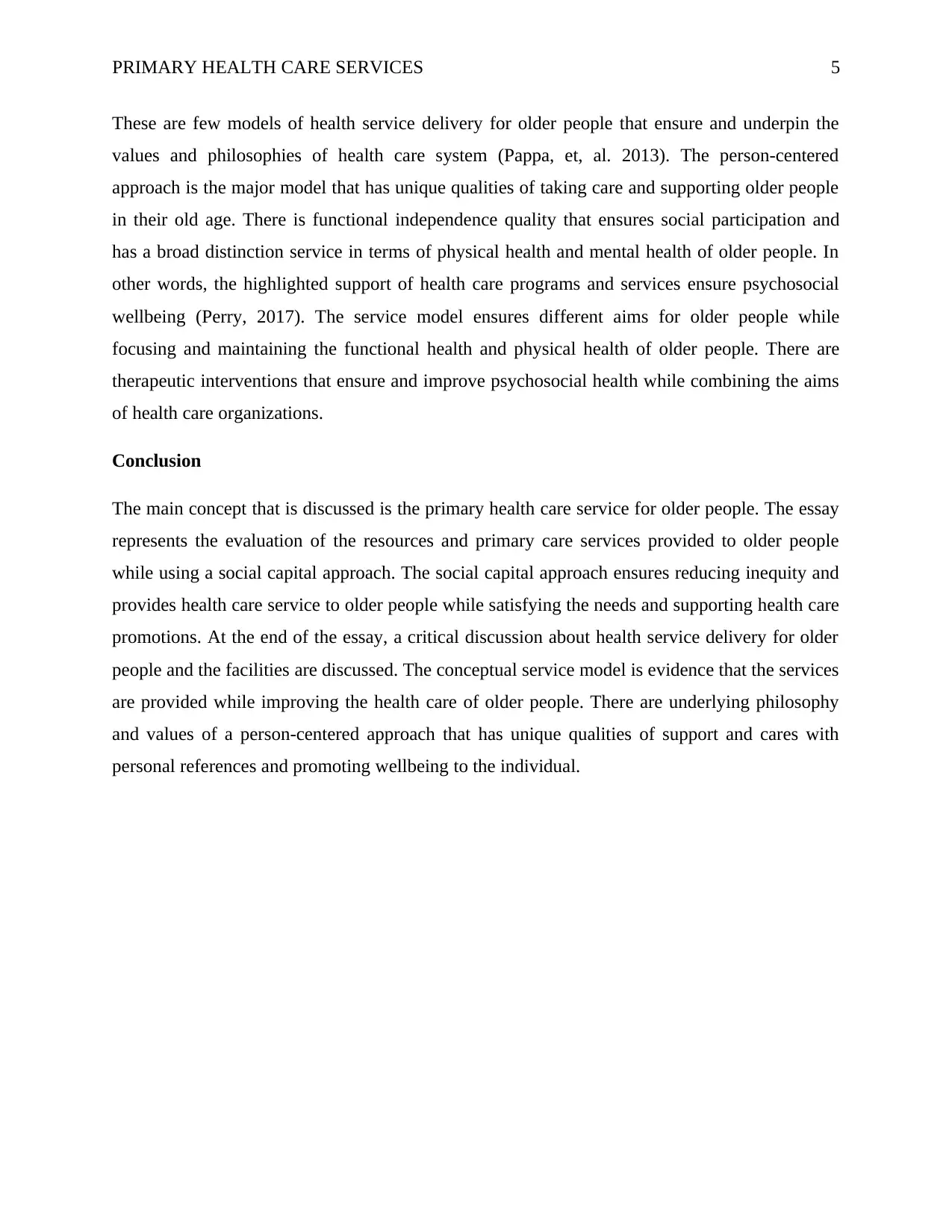
PRIMARY HEALTH CARE SERVICES 5
These are few models of health service delivery for older people that ensure and underpin the
values and philosophies of health care system (Pappa, et, al. 2013). The person-centered
approach is the major model that has unique qualities of taking care and supporting older people
in their old age. There is functional independence quality that ensures social participation and
has a broad distinction service in terms of physical health and mental health of older people. In
other words, the highlighted support of health care programs and services ensure psychosocial
wellbeing (Perry, 2017). The service model ensures different aims for older people while
focusing and maintaining the functional health and physical health of older people. There are
therapeutic interventions that ensure and improve psychosocial health while combining the aims
of health care organizations.
Conclusion
The main concept that is discussed is the primary health care service for older people. The essay
represents the evaluation of the resources and primary care services provided to older people
while using a social capital approach. The social capital approach ensures reducing inequity and
provides health care service to older people while satisfying the needs and supporting health care
promotions. At the end of the essay, a critical discussion about health service delivery for older
people and the facilities are discussed. The conceptual service model is evidence that the services
are provided while improving the health care of older people. There are underlying philosophy
and values of a person-centered approach that has unique qualities of support and cares with
personal references and promoting wellbeing to the individual.
These are few models of health service delivery for older people that ensure and underpin the
values and philosophies of health care system (Pappa, et, al. 2013). The person-centered
approach is the major model that has unique qualities of taking care and supporting older people
in their old age. There is functional independence quality that ensures social participation and
has a broad distinction service in terms of physical health and mental health of older people. In
other words, the highlighted support of health care programs and services ensure psychosocial
wellbeing (Perry, 2017). The service model ensures different aims for older people while
focusing and maintaining the functional health and physical health of older people. There are
therapeutic interventions that ensure and improve psychosocial health while combining the aims
of health care organizations.
Conclusion
The main concept that is discussed is the primary health care service for older people. The essay
represents the evaluation of the resources and primary care services provided to older people
while using a social capital approach. The social capital approach ensures reducing inequity and
provides health care service to older people while satisfying the needs and supporting health care
promotions. At the end of the essay, a critical discussion about health service delivery for older
people and the facilities are discussed. The conceptual service model is evidence that the services
are provided while improving the health care of older people. There are underlying philosophy
and values of a person-centered approach that has unique qualities of support and cares with
personal references and promoting wellbeing to the individual.
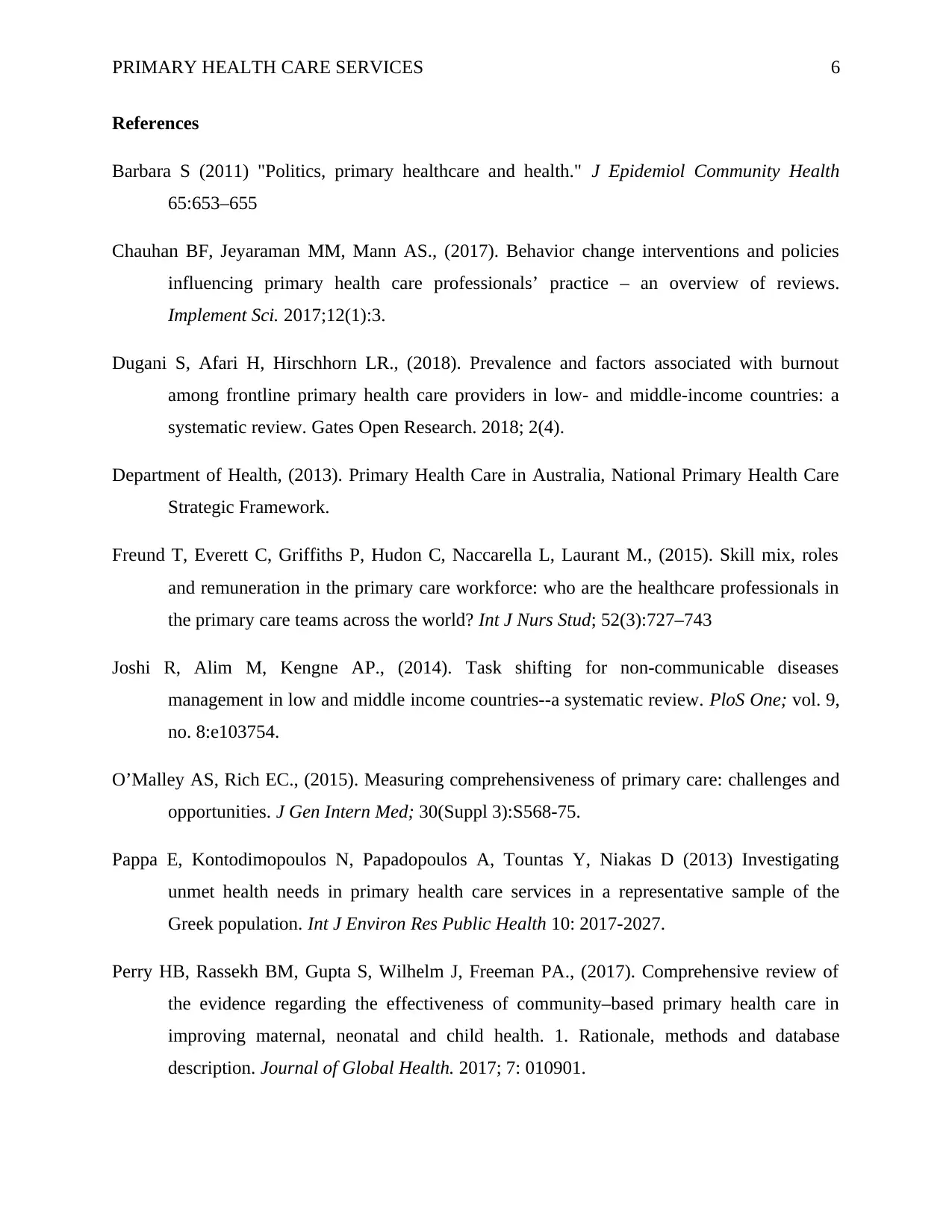
PRIMARY HEALTH CARE SERVICES 6
References
Barbara S (2011) "Politics, primary healthcare and health." J Epidemiol Community Health
65:653–655
Chauhan BF, Jeyaraman MM, Mann AS., (2017). Behavior change interventions and policies
influencing primary health care professionals’ practice – an overview of reviews.
Implement Sci. 2017;12(1):3.
Dugani S, Afari H, Hirschhorn LR., (2018). Prevalence and factors associated with burnout
among frontline primary health care providers in low- and middle-income countries: a
systematic review. Gates Open Research. 2018; 2(4).
Department of Health, (2013). Primary Health Care in Australia, National Primary Health Care
Strategic Framework.
Freund T, Everett C, Griffiths P, Hudon C, Naccarella L, Laurant M., (2015). Skill mix, roles
and remuneration in the primary care workforce: who are the healthcare professionals in
the primary care teams across the world? Int J Nurs Stud; 52(3):727–743
Joshi R, Alim M, Kengne AP., (2014). Task shifting for non-communicable diseases
management in low and middle income countries--a systematic review. PloS One; vol. 9,
no. 8:e103754.
O’Malley AS, Rich EC., (2015). Measuring comprehensiveness of primary care: challenges and
opportunities. J Gen Intern Med; 30(Suppl 3):S568-75.
Pappa E, Kontodimopoulos N, Papadopoulos A, Tountas Y, Niakas D (2013) Investigating
unmet health needs in primary health care services in a representative sample of the
Greek population. Int J Environ Res Public Health 10: 2017-2027.
Perry HB, Rassekh BM, Gupta S, Wilhelm J, Freeman PA., (2017). Comprehensive review of
the evidence regarding the effectiveness of community–based primary health care in
improving maternal, neonatal and child health. 1. Rationale, methods and database
description. Journal of Global Health. 2017; 7: 010901.
References
Barbara S (2011) "Politics, primary healthcare and health." J Epidemiol Community Health
65:653–655
Chauhan BF, Jeyaraman MM, Mann AS., (2017). Behavior change interventions and policies
influencing primary health care professionals’ practice – an overview of reviews.
Implement Sci. 2017;12(1):3.
Dugani S, Afari H, Hirschhorn LR., (2018). Prevalence and factors associated with burnout
among frontline primary health care providers in low- and middle-income countries: a
systematic review. Gates Open Research. 2018; 2(4).
Department of Health, (2013). Primary Health Care in Australia, National Primary Health Care
Strategic Framework.
Freund T, Everett C, Griffiths P, Hudon C, Naccarella L, Laurant M., (2015). Skill mix, roles
and remuneration in the primary care workforce: who are the healthcare professionals in
the primary care teams across the world? Int J Nurs Stud; 52(3):727–743
Joshi R, Alim M, Kengne AP., (2014). Task shifting for non-communicable diseases
management in low and middle income countries--a systematic review. PloS One; vol. 9,
no. 8:e103754.
O’Malley AS, Rich EC., (2015). Measuring comprehensiveness of primary care: challenges and
opportunities. J Gen Intern Med; 30(Suppl 3):S568-75.
Pappa E, Kontodimopoulos N, Papadopoulos A, Tountas Y, Niakas D (2013) Investigating
unmet health needs in primary health care services in a representative sample of the
Greek population. Int J Environ Res Public Health 10: 2017-2027.
Perry HB, Rassekh BM, Gupta S, Wilhelm J, Freeman PA., (2017). Comprehensive review of
the evidence regarding the effectiveness of community–based primary health care in
improving maternal, neonatal and child health. 1. Rationale, methods and database
description. Journal of Global Health. 2017; 7: 010901.
⊘ This is a preview!⊘
Do you want full access?
Subscribe today to unlock all pages.

Trusted by 1+ million students worldwide
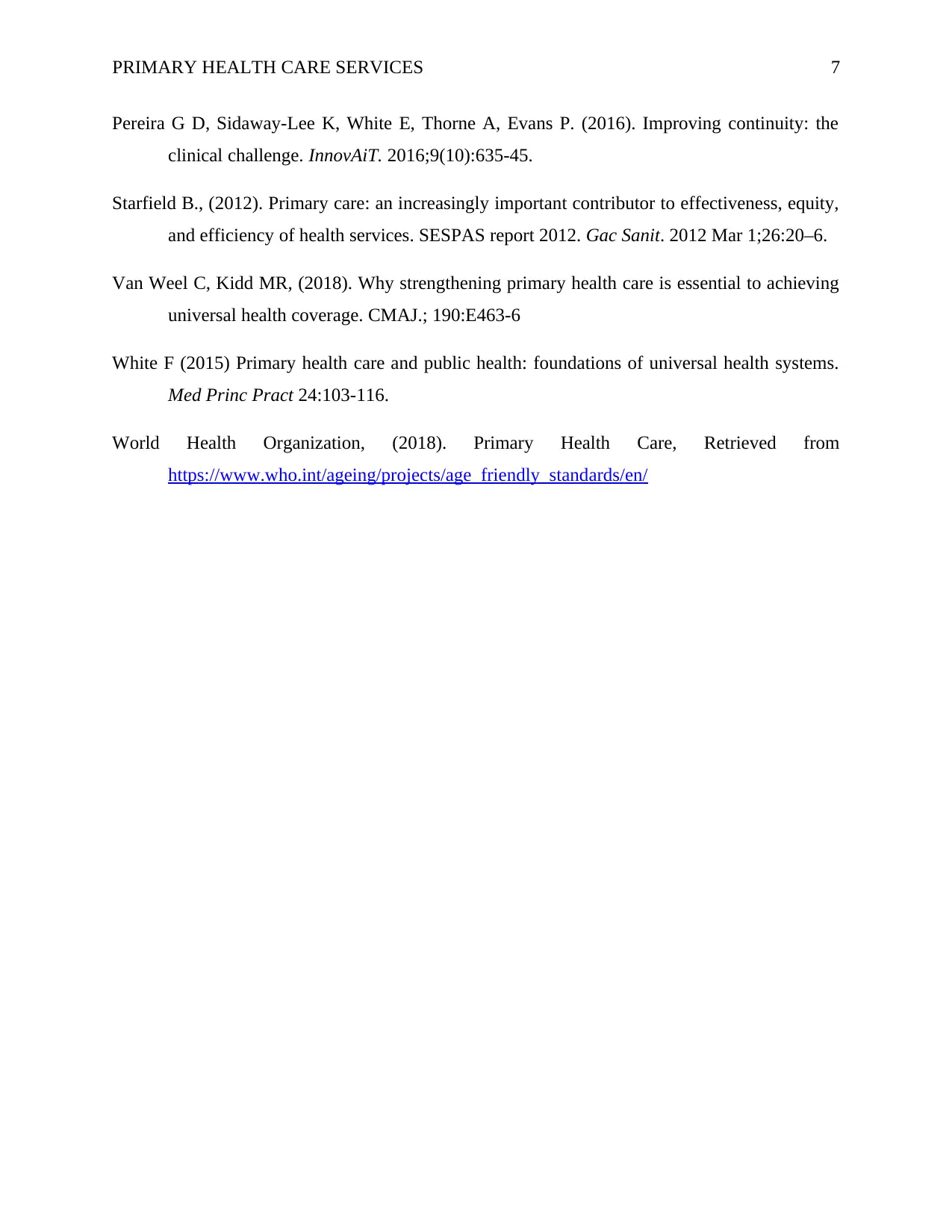
PRIMARY HEALTH CARE SERVICES 7
Pereira G D, Sidaway-Lee K, White E, Thorne A, Evans P. (2016). Improving continuity: the
clinical challenge. InnovAiT. 2016;9(10):635-45.
Starfield B., (2012). Primary care: an increasingly important contributor to effectiveness, equity,
and efficiency of health services. SESPAS report 2012. Gac Sanit. 2012 Mar 1;26:20–6.
Van Weel C, Kidd MR, (2018). Why strengthening primary health care is essential to achieving
universal health coverage. CMAJ.; 190:E463-6
White F (2015) Primary health care and public health: foundations of universal health systems.
Med Princ Pract 24:103-116.
World Health Organization, (2018). Primary Health Care, Retrieved from
https://www.who.int/ageing/projects/age_friendly_standards/en/
Pereira G D, Sidaway-Lee K, White E, Thorne A, Evans P. (2016). Improving continuity: the
clinical challenge. InnovAiT. 2016;9(10):635-45.
Starfield B., (2012). Primary care: an increasingly important contributor to effectiveness, equity,
and efficiency of health services. SESPAS report 2012. Gac Sanit. 2012 Mar 1;26:20–6.
Van Weel C, Kidd MR, (2018). Why strengthening primary health care is essential to achieving
universal health coverage. CMAJ.; 190:E463-6
White F (2015) Primary health care and public health: foundations of universal health systems.
Med Princ Pract 24:103-116.
World Health Organization, (2018). Primary Health Care, Retrieved from
https://www.who.int/ageing/projects/age_friendly_standards/en/
1 out of 7
Related Documents
Your All-in-One AI-Powered Toolkit for Academic Success.
+13062052269
info@desklib.com
Available 24*7 on WhatsApp / Email
![[object Object]](/_next/static/media/star-bottom.7253800d.svg)
Unlock your academic potential
Copyright © 2020–2025 A2Z Services. All Rights Reserved. Developed and managed by ZUCOL.





